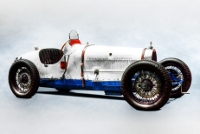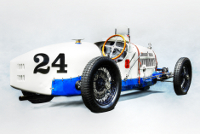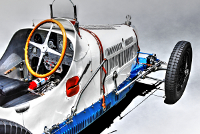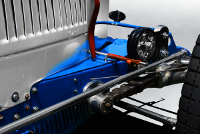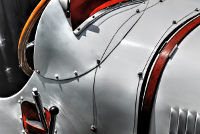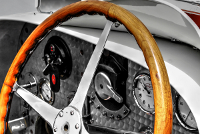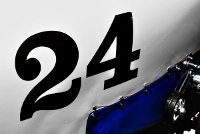Location:
Pebble Beach Concours d'Elegance, 2009
Owner: Jay Leno | Burbank, California
Prologue:
Anyone can get acquainted with this wonderful little car thanks to Jay Leno's popular video series. Among the Bugatti cars on display at Pebble Beach, I was drawn to this example for its colorful preparation and wire wheels. The fire extinguisher and bolt-on instrument panel also spoke to the car's regular use, which I admired. And being Jay's, a hang tag announced that the car was displayed outside of the judged classes—a participant on its own merits, not a car with any pretention of taking home an award. Well, I certainly admire the history behind the car. As for Jay, he was on-hand and on-stage, trading verbal jabs with then-governor Schwarzenegger. There was one moment during the show, however, and I can't remember what I was shooting, but ahead of me I heard a commotion and looked up as Jay swept past me with a string of pleasantly nauthest hi-haw'ah'yahs. Ah well, I was engrossed in whatever was on the other side of my lens, but that's Pebble Beach and the reason to be there in the first place.
- - - - - - - - - -
► Image Source: Nikon D200 (10.2 MP)
References:
- Jay Leno's Garage: Going right to the source, this piece takes you inside and out on the road with this fantastic little car.
- UltimateCarPage: Providing technical specifications on the Type 37A, by Wouter Melissen, (prior to December, 2004).
- RM Sotheby's: A beautiful spread of chassis #37343, which sold at Amelia Island in 2014.
- Historic Racing: For those seeking more information on Pierre Veyron, this site offers a nice biography.
- Forix Motorsport Stats: A rather detailed account of Benoist, Williams, and Wimille in the French Resistance.
Chassis #37316 was formerly owned by the late Robert Dunlap. Dunlap was a founding member of the American Bugatti Club (ABC), originally its secretary and later its president. According to the owner of record, this Type 37A was the third car logged in the ABC club registry. As for that owner of record, it is of course Jay Leno, perhaps America's greatest ambassador of the classic car—meaning he sets the community's standard for sharing and generosity, to say nothing of the respect he displays for the preservation and real-world use of the vehicles he owns.
About the car, the Type 37A is the baby brother of the Type 35, though its internals are based on the more tractable Type 40. From a 1½ litre overhead cam straight four there's 60 brake horsepower. In a lightweight car comprised of a semi-hollow, belly-style chassis with a thin tapertail body held together by copper safety wire, that kind of power is good enough for speeds near 100 miles per hour. According to Jay, this car was third in the 1928 Targa Florio—perhaps its biggest stage—although in that case the driver was likely Carlo Alberto "Caberto" Conelli, an Italian count who often raced Bugatti cars.
Main differences from the Type 35 include half the cylinders, the use of plain bearings—meaning no rollers, and therefore a simpler and more durable motor—and a smaller supercharger. In this layout there are still three valves per cylinder—two intake and one exhaust—and bevel-drive to the camshaft. Absent, however, are the single-cast alloy wheels and brakes that were particular to Grand Prix Bugatti cars, opting for conventional wires instead. Again, this omission meant the Type 37A was less complex and less costly, making it ideal for voiturette racing.
Modern additions to #37316 include an electric fuel pump and horn for driving in traffic, and an alternator that runs on a pulley off the driveshaft. The alternator's position is less visually obtrusive than on some other examples used for modern driving, though of course it only charges when the car is moving.
Pierre Veyron, Bugatti, and the French Resistance
This well known Bugatti was the personal car of test driver Pierre Veyron, who, in addition to contributions technical, won numerous Grand Prix races for Bugatti. Perhaps his greatest victory, Veyron won the 24 hours of Le Mans in 1939 alongside Jean-Pierre Wimille. But that aside, and so much more vitally, Veyron served as a member of the French Resistance against German occupation during World War II. Wimille, too, was a member of the Resistance, along with countless other members of the motoring community whose engineering connections proved valuable against enemy weapons planning and production. Veyron either worked with, or was part of a cell named 'Chestnut.'
This sabotage unit was started in part by fellow racer Charles Frederick William Grover, a francophile Englishman often known to the history books as simply "Williams." The unit included Wimille and a fourth Bugatti racing driver, Robert Benoist. The wartime departure for these French sportsmen was obviously perilous; many were captured and some unfortunately executed, Williams and Benoist among them. Veyron himself was fortunate to elude the Germans, and in 1945 he received the French Legion of Honour for his service.
Most accounts state that following the War he distanced himself from the motoring life he'd once led, and thus his name remained obscure outside of France until Bugatti—now German-owned—honored his memory with the naming of its first hypercar in 2005. And so it's a strangely woven basket of nationalistic tendencies and motoring enthusiasm that brought us the modern-day Bugatti Veyron, but the roots of the story are assuredly, appropriately French.
Motor: 1,496 cc straight 4-cylinder, cast iron monoblock | 69 mm x 100 mm | 7.0:1 compression
Valvetrain: SOHC, 3 valves per cylinder (2 intake, 1 exhaust)
Aspiration: single Zenith carburetor, supercharged
Power: 60 bhp @ somewhere north of 4,500 rpm (redline 6,000 rpm)
Drivetrain: 4-speed manual transmission, rear-wheel drive
Front Suspension: solid axle with semi-elliptic leafsprings
Rear Suspension: solid axle with quarter elliptic leafsprings
Architecture: steel body on steel chassis
Kerb Weight: 700 kg (1,543 lbs)
Wheelbase: 2,400 mm (94.488 inches)
Top Speed: 152 km/h (94 mph)
Etymology:
A combination of the all-conquering Type 35 and the road-going Type 40, the Type 37 offered half the cylinders of the top-line Grand Prix car, and much simpler engineering. The 'A' designation signifies that this particular car, #37316, is a factory supercharged version. Though a voiturette, the Type 37A was quick enough to compete alongside the Type 35 in Grand Prix racing.
Figures:
Around 286 Type 37 cars were built. Of these, between 67 and 76 were the factory-supercharged Type 37A.
Plan Sophistication: Details of Bugatti Type 37A Construction
On the exterior flank, note the circular hole set high in the bonnet for the popoff valve, a staple of the supercharged Bugatti. Below the bonnet louvres is the steering linkage. Aft, the tall lever that connects at the frame is a hand brake, while the short lever seated in the flank pocket is the shift lever. Also noteworthy is the complement of copper safety wire, which holds the steel body together. Brakes are cable operated. Our suspension details show how the wire, leather, and bolts hold the machine together by means that are part bicycle and part horse cart. But it's all very light and very effective, designed with a minimalism that placed the car's performance in the realm of the razor sharp well before contemporary motorists understood what that meant.
In Control: Description of the Type 37A Instrumentation and Controls
The spark advance is located to the left of the steering wheel, just inside the oil pressure gauge. The magneto pokes through the dashboard just above. The pump on the far side of the dash below the ignition is the oil pump, while the lever that lops down toward the mechanic's seat activates an auxiliary oil tank. The small panel underneath the dash holds the modern fuel pump and horn, while the fire extinguisher totes itself along for safety. One Brooklands screen fronts the driver, and a MotoMeter temperature gauge sets the aim down at the end of the nose.
Sight and Sound: The Conundrum of Antique Machinery with Modern Performance
About the shape, well it's a sparrow-light tax on the eyes and so tightly packed that half the driver's commands happen outside the cockpit. This is all typical of Bugatti's uncompromising view of motoring. So much about the car happens on the exterior—the suspension, braking, shifting, and steering—and it's all directed by narrow tyres with noticeable camber. Watching and listening to Jay Leno's driving video of this car is a must just to witness how such an antiquated device can act so unabashedly modern on the road.
Last Updated: Mar 26, 2025

